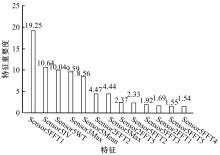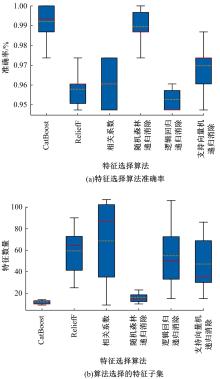吉林大学学报(工学版) ›› 2022, Vol. 52 ›› Issue (8): 1951-1956.doi: 10.13229/j.cnki.jdxbgxb20210176
• 农业工程·仿生工程 • 上一篇
基于多传感器优化的农药残留快速检测新方法
李佩泽1,2( ),赵世舜1,翁小辉3,蒋鑫妹4,崔洪博4,乔建磊4,常志勇5,6(
),赵世舜1,翁小辉3,蒋鑫妹4,崔洪博4,乔建磊4,常志勇5,6( )
)
- 1.吉林大学 数学学院,长春 130012
2.吉林大学 人工智能学院,长春 130012
3.吉林大学 机械与航空航天工程学院,长春 130022
4.吉林农业大学 园艺学院,长春 130118
5.吉林大学 工程仿生教育部重点实验室,长春 130022
6.吉林大学 生物与农业工程学院,长春 130022
A new method for rapid detection of pesticide residues based on multi⁃sensor optimization
Pei-ze LI1,2( ),Shi-shun ZHAO1,Xiao-hui WENG3,Xin-mei JIANG4,Hong-bo CUI4,Jian-lei QIAO4,Zhi-yong CHANG5,6(
),Shi-shun ZHAO1,Xiao-hui WENG3,Xin-mei JIANG4,Hong-bo CUI4,Jian-lei QIAO4,Zhi-yong CHANG5,6( )
)
- 1.College of Mathematics,Jilin University,Changchun 130012,China
2.School of Artificial Intelligence,Jilin University,Changchun 130012,China
3.School of Mechanical and Aerospace Engineering,Jilin University,Changchun 130022,China
4.College of Horticulture,Jilin Agricultural University,Changchun 130118,China
5.Key Laboratory of Bionic Engineering,Ministry of Education,Jilin University,Changchun 130022,China
6.College of Biological and Agricultural Engineering,Jilin University,Changchun 130022,China
摘要:
提出了一种基于CatBoost算法的传感器阵列优化策略。采用自行研制的基于仿生嗅觉的电子鼻测试系统,检测蒲公英上残留的农药敌百虫,提取蒲公英样本的响应特征信息,对传感器阵列进行多特征数据融合。使用CatBoost算法对数据矩阵进行特征选择,优化后的传感器数量从12个减少到3个,准确率从91.69%提高到98.03%,减少了约88%的特征值,优于相关系数、递归消除和其他常用算法,解决了传感器繁多、数据冗余的问题,大大提高了检测精度。结果表明:在蒲公英敌百虫残留检测上使用CatBoost算法可提高电子鼻的鉴别能力。
中图分类号:
- S481.8
| 1 | Boroduleva A, Wu J, Yang Q, et al. Development of fluorescence polarization immunoassays for parallel detection of pesticides carbaryl and triazophos in wheat grains[J]. Analytical Methods, 2017,9(48): 6814-6822. |
| 2 | Abdallah O I, Malhat F M. Thiacloprid residues in green onion (allium cepa) using micro liquid-liquid extraction and liquid chromatography-tandem mass spectrometry[J]. Agricultural Research, 2020, 9(3): 340-348. |
| 3 | Mercader J V, Agullo C, Abad-Somovilla A, et al. A monoclonal antibody-based immunoassay for mepanipyrim residue sensitive analysis in grape juice and wine[J]. Food Analytical Methods, 2020, 13(3): 770-779. |
| 4 | 常志勇, 陈东辉, 佟月英, 等. 基于人体嗅觉特征的猪肉新鲜度仿生电子鼻检测技术[J].吉林大学学报:工学版, 2012, 42(): 131-134. |
| Chang Zhi-yong, Chen Dong-hui, Tong Yue-ying, et al. Human olfactory feature based bionic electronic nose technology for pork freshness detection[J]. Journal of Jilin University(Engineering and Technology Edition), 2012, 42(Sup.1): 131-134. | |
| 5 | 常志勇, 陈东辉, 张凌, 等.基于多传感器融合的鸡肉新鲜度检测方法[J].吉林大学学报: 工学版, 2013, 43(): 493-496. |
| Chang Zhi-yong, Chen Dong-hui, Zhang Ling, et al. Method of chicken freshness detection based on multi-sensor fusion[J]. Journal of Jilin University(Engineering and Technology Edition), 2013, 43(Sup.1): 493-496. | |
| 6 | Sun H, Tian F, Liang Z, et al. Sensor array optimization of electronic nose for detection of bacteria in wound infection[J]. IEEE Transactions on Industrial Electronics, 2017, 64(9): 7350-7358. |
| 7 | Cipriano D, Capelli L. Evolution of electronic noses from research objects to engineered environmental odour monitoring systems: a review of standardization approaches[J]. Biosensors, 2019, 9(2): 75. |
| 8 | Amkor A, El Barbri N. A measurement prototype based on gas sensors for detection of pesticide residues in edible mint[J]. Journal of Food Measurement and Characterization, 2021, 15(1): 170-180. |
| 9 | 翁小辉, 栾祥宇, 陈冬雪, 等.基于特征提取的烃类气体电子鼻检测方法[J].吉林大学学报: 工学版, 2020, 50(6): 2306-2312. |
| Weng Xiao-hui, Luan Xiang-yu, Chen Dong-xue, et al. Electronic nose detection for hydrocarbon gas based on feature extraction[J]. Journal of Jilin University(Engineering and Technology Edition), 2020, 50(6): 2306-2312. | |
| 10 | Xu K, Wang J, Wei Z, et al. An optimization of the MOS electronic nose sensor array for the detection of Chinese pecan quality[J]. Journal of Food Engineering, 2017, 203: 25-31. |
| 11 | Liu T, Zhang W, McLean P, et al. Electronic nose-based odor classification using genetic algorithms and fuzzy support vector machines[J]. International Journal of Fuzzy Systems, 2018, 20(4): 1309-1320. |
| 12 | Yan K, Zhang D. Feature selection and analysis on correlated gas sensor data with recursive feature elimination[J]. Sensors and Actuators B-Chemical, 2015, 212: 353-363. |
| 13 | Prokhorenkova L, Gusev G, Vorobev A, et al. CatBoost: unbiased boosting with categorical features[J]. Advances in Neural Information Processing Systems, 2018, 31: 6638-6648. |
| 14 | Hamzah H, Bustamam A, Yanuar A, et al. Predicting the molecular structure relationship and the biological activity of DPP-4 inhibitor using deep neural network with CatBoost method as feature selection[C]∥12th International Conference on Advanced Computer Science and Information Systems, Depok, Indonesia, 2020: 101-107. |
| 15 | .食品中农药最大残留限量 [S]. |
| 16 | Razavi M R. Gender differences in the effect of virtual social networks use on students' academic performance[J].Current Psychology,2021,40(2): 744-750. |
| [1] | 周丰丰,朱海洋. 基于三段式特征选择策略的脑电情感识别算法SEE[J]. 吉林大学学报(工学版), 2022, 52(8): 1834-1841. |
| [2] | 王斌,何丙辉,林娜,王伟,李天阳. 基于随机森林特征选择的茶园遥感提取[J]. 吉林大学学报(工学版), 2022, 52(7): 1719-1732. |
| [3] | 王生生,姜林延,杨永波. 基于最优传输特征选择的医学图像分割迁移学习[J]. 吉林大学学报(工学版), 2022, 52(7): 1626-1638. |
| [4] | 李景彬,杨禹锟,温宝琴,坎杂,孙雯,杨朔. 基于根茬检测的秋后残膜回收导航路径提取方法[J]. 吉林大学学报(工学版), 2021, 51(4): 1528-1539. |
| [5] | 翁小辉,孙友宏,张书军,谢军,常志勇. 基于仿生鼻腔优化的油气检测方法与实验新技术[J]. 吉林大学学报(工学版), 2020, 50(1): 382-388. |
| [6] | 王鹏宇,赵世杰,马天飞,熊晓勇,程馨. 基于联合概率数据关联的车用多传感器目标跟踪融合算法[J]. 吉林大学学报(工学版), 2019, 49(5): 1420-1427. |
| [7] | 高万夫,张平,胡亮. 基于已选特征动态变化的非线性特征选择方法[J]. 吉林大学学报(工学版), 2019, 49(4): 1293-1300. |
| [8] | 刘杰, 张平, 高万夫. 基于条件相关的特征选择方法[J]. 吉林大学学报(工学版), 2018, 48(3): 874-881. |
| [9] | 袁哲明, 张弘杨, 陈渊. 基于特征选择和支持向量机的HIV-1型蛋白酶剪切位点预测[J]. 吉林大学学报(工学版), 2017, 47(2): 639-646. |
| [10] | 代琨,于宏毅,仇文博,李青. 基于SVM的网络数据无监督特征选择算法[J]. 吉林大学学报(工学版), 2015, 45(2): 576-582. |
| [11] | 王刚, 张禹瑄, 李颖, 陈慧灵, 胡玮通, 秦磊. 一种微阵列数据降维新方法[J]. 吉林大学学报(工学版), 2014, 44(5): 1429-1434. |
| [12] | 姚登举, 杨静, 詹晓娟. 基于随机森林的特征选择算法[J]. 吉林大学学报(工学版), 2014, 44(01): 137-141. |
| [13] | 常志勇, 陈东辉, 张凌, 佟月英, 翁小辉, 佟金. 基于多传感器融合的鸡肉新鲜度检测方法[J]. 吉林大学学报(工学版), 2013, 43(增刊1): 493-496. |
| [14] | 杨小军, 宋青松, 马祥, 李东海. 基于多模型信息滤波器的故障容错目标跟踪[J]. 吉林大学学报(工学版), 2013, 43(05): 1381-1385. |
| [15] | 常志勇, 陈东辉, 佟月英, 佟金, 谢军. 基于人体嗅觉特征的猪肉新鲜度仿生电子鼻检测技术[J]. 吉林大学学报(工学版), 2012, 42(增刊1): 131-134. |
|
||







